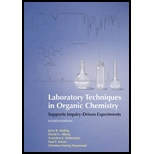
Laboratory Techniques in Organic Chemistry
4th Edition
ISBN: 9781464134227
Author: Jerry R. Mohrig, David Alberg, Gretchen Hofmeister, Paul F. Schatz, Christina Noring Hammond
Publisher: W. H. Freeman
expand_more
expand_more
format_list_bulleted
Concept explainers
Question
Chapter 1, Problem 6Q
Interpretation Introduction
Interpretation:
The CAS number of all the reagents used and products synthesized in the reaction to synthesize the aspirin should be determined.
Concept introduction:
CAS numberis simple and regular datathat is helpful for database searches. They provide a reliable link to every specified substance apartfrom the various nomenclatures and disciplines used by the chemical industry. Each number assigned by the CAS is unique to a particular chemical compound. There is no correlation to the scientific chemical number for the substance.
Expert Solution & Answer
Want to see the full answer?
Check out a sample textbook solution
Students have asked these similar questions
Please help me with identifying these.
Can I please get help with this?
Can I please get help with identifying these?
Chapter 1 Solutions
Laboratory Techniques in Organic Chemistry
Knowledge Booster
Learn more about
Need a deep-dive on the concept behind this application? Look no further. Learn more about this topic, chemistry and related others by exploring similar questions and additional content below.Similar questions
- For the reaction: CO2(g) + H2(g) --> CO (g) + H2O (g) Kc= 0.64 at 900 degrees celcius. if initially you start with 1.00 atmoshpere of carbon dioxide and 1 atmoshpere of hydrogen gas, what are the equilibrium partial pressuses of all species.arrow_forwardCan I please get this answered? With the correct number of significant digits.arrow_forwardDraw the Hofmann product of the dehydroiodination of this alkyl iodide. ☐ : + Explanation Check esc F1 2 3 I 88 % 5 F5 I. X © tBuOK Click and drag to sta drawing a structure. © 2025 McGraw Hill LLC. All Rights Reserved. Te BI BB F6 W E R Y S H Karrow_forward
arrow_back_ios
SEE MORE QUESTIONS
arrow_forward_ios
Recommended textbooks for you
 Organic ChemistryChemistryISBN:9781305580350Author:William H. Brown, Brent L. Iverson, Eric Anslyn, Christopher S. FootePublisher:Cengage Learning
Organic ChemistryChemistryISBN:9781305580350Author:William H. Brown, Brent L. Iverson, Eric Anslyn, Christopher S. FootePublisher:Cengage Learning

Organic Chemistry
Chemistry
ISBN:9781305580350
Author:William H. Brown, Brent L. Iverson, Eric Anslyn, Christopher S. Foote
Publisher:Cengage Learning